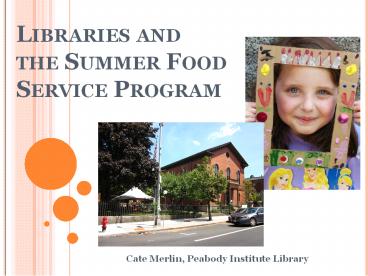Libraries and the Summer Food Service Program - PowerPoint PPT Presentation
1 / 9
Title:
Libraries and the Summer Food Service Program
Description:
LIBRARIES AND THE SUMMER FOOD SERVICE PROGRAM Cate Merlin, Peabody Institute Library – PowerPoint PPT presentation
Number of Views:81
Avg rating:3.0/5.0
Title: Libraries and the Summer Food Service Program
1
Libraries and the Summer Food Service Program
- Cate Merlin, Peabody Institute Library
2
Why is this program needed?
- Of Peabodys population of 51,000, 6 of families
live below the poverty line - The kids and teens who spend their afternoons and
summers at the PIL often do not have reliable
computer or internet access at home, and use the
library for this technology as well as our
programs, events and Makerspace equipment and
classes - Kids who need free or discounted school lunches
still need somewhere to eat during the summer
3
Why libraries?
- Neutral place for children and teens to
comfortably eat lunch without stigma or
embarrassment of needing free food - Known community center
- Usual summer programming partnered with lunches
is an easy tie-in for kids and the library - Specialized programming
(week-long camps, etc.)
becomes possible now
that lunch is included
4
How it Works
- At the PIL, lunch is served from at 12pm Mondays-
Thursdays during the summer, with a craft or
activity available to children and teens after
lunch. Daily attendance since the program began
in 2009 is between 30-50 kids, depending on the
year, weather, etc. - Do kids have to sign up?
- Who provides the food?
- Who serves the food?
- Staff Requirements
- Space Requirements
- Equipment Requirements
5
Community Partners
6
Best Practices
- Full commitment by all library staff is needed.
This is a big undertaking, depending on
attendance, and having the support of all staff
is necessary for kids and teens to truly feel
welcome to eat, laugh and be merry in a setting
that doesnt always encourage eating and noise,
especially in the same place! - A dedicated staff member in charge of day-to-day
technicalities (food temperature, lunch counts,
etc.) turns
the program in a
well-oiled machine - Teen/adult volunteers can help with
set up, distribution and after-lunch
activities and programs (bonus if your
library has
access to summer internship or
volunteer program for local teens)
7
Best Practices
- Community partners can help advertise, staff and
promote your Summer Foods program. Even if an
organization cant contribute financially, they
can still donate the time and effort of employees
and volunteers. - Advertise programs and events that include lunch,
so parents know their kids will both have access
to a nutritious meal while participating in fun
activities - School districts are often able to place
robo-calls informing all parents of Summer
Foods program- this will bring incredible
attendance, so only do this if youre prepared! - Grants to purchase programming equipment (i.e.
tables, chairs, playground toys) or supplies for
specific programs and events can expand your
programming abilities and provide support for
truly amazing summer events that combine the SFSP
with the national summer reading theme
8
UNMASK! Summer 2015 Funded by a generous grant
from Project Bread
9
Tips Resources to Start an SFSP _at_ Your Library
- Think about how the SFSP fits into your library
and its mission. Why should your library run
summer foods? Thinking through this part early
will help if your colleagues and potential
partners have questions about the librarys role
in a program like this. - Talk to your library director and co-workers
about the SFSP. Explain why you think your
library should get involved. - See if a SFSP is already operating in your
community. If so, it may be fairly easy to add
your library as a feeding site. The public school
Food Service Department in your city or town may
be a good place to start. - If you are starting from scratch, contact the
state agency in charge of Child Nutrition
Programs. To find your states agency, check out
http//www.fns.usda.gov/cnd/Contacts/StateDirector
y.htmM - Brainstorm partners. Start with organizations in
your community who have an interest in serving
youth (schools, churches, recreation departments,
YMCAs,), but dont stop there. If a potential
partner cant participate, think outside the box
about who else could fulfill the needed role. - Involve elected officials early. Your mayor,
council and school board members or library
trustees may have contacts and influence that can
benefit your SFSP. - Explore funding options. The federal
reimbursement rate may not cover all expenses,
especially if you plan to offer programs and
activities at your site. In Massachusetts, the
statewide non-profit Project Bread
(www.projectbread.org) offers grants for new
sponsors and sites and for programs wishing to
offer locally grown produce as part of their
summer meals. Also, consider local businesses,
hospitals and foundations as potential funders. - Dont limit partners to only those who can
provide financial support. Look for in-kind
contributions and for partners who can step in
for each other should problems arise.































